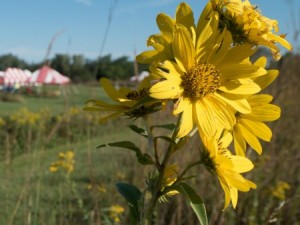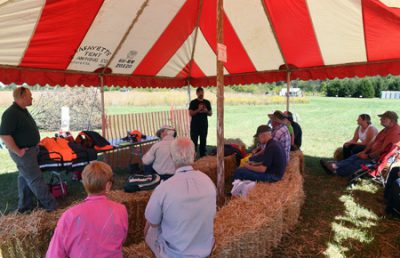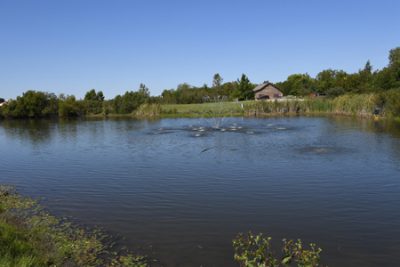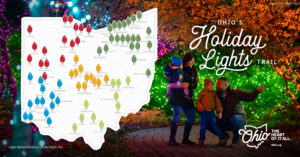Check out the Gwynne Conservation Area at Farm Science Review

A prairie flower blooms in the Gwynne Conservation Area during the 2016 Farm Science Review. (Photo: CFAES.)

LONDON, Ohio — A short wagon ride away from Farm Science Review’s rows of gleaming tractors, its grounds full of hundreds of exhibitors, its streets packed by thousands of visitors, you’ll see another side of agriculture.
Its waters, woods and wildlife.
Welcome to the Review’s Gwynne Conservation Area, where Deer Creek flows in the shade of a forest. Bluegill fish dimple the surface of ponds. Killdeer birds call from a wetland mudflat. The wind rustles big bluestem prairie grass. And many of the Review’s expected 100,000-plus visitors will find ideas on caring for their land.
The Review, set for Sept. 19-21 in London, Ohio, is one of the largest agricultural trade shows in the U.S. Sponsored by The Ohio State University’s College of Food, Agricultural, and Environmental Sciences (CFAES), it bursts forth annually at the college’s 2,100-acre Molly Caren Agricultural Center.
The 67-acre Gwynne area is a modest green corner of that center.

Gwynne tent at FSR
For 362 days a year, the site, called “the Gwynne” for short, is used to demonstrate and teach about farm-related conservation practices — ways to aid soils, streams, ponds, forests, grasslands and the creatures that live there.
Hear 50-plus talks about conservation, nature
Then, during the three days of the Review, it offers a slate of expert-led talks on the topics, more than 50 in all, plus displays, exhibits and demonstrations. Cool shade, too.
The talks “can help landowners make decisions to better manage the resources on their property,” from forests to streams to pastures and more, said co-organizer Mary Griffith, agriculture and natural resources educator in Ohio State University Extension’s Madison County office. OSU Extension is CFAES’s outreach arm.
“Making decisions that promote the health of these ecosystems can save landowners time and money in the long run,” she said.

Kathy Smith, CFAES’s forestry program coordinator, said the Gwynne’s hot topics this year will include planting for pollinators (such as honey bees and monarch butterflies), using chainsaws safely (Ohio has millions of standing dead ash trees, killed by the emerald ash borer pest), and growing grasslands and pastures for livestock. She’ll give a talk on identifying trees.
See plants for grass-fed, pastured livestock
A new demonstration area in the Gwynne features grasses and clovers a farmer can grow to feed grass-fed and pasture-raised livestock. Eleven related talks will cover topics including year-round grazing, growing warm-season grasses and stockpiling winter forage.
“These are great opportunities for landowners interested in establishing or improving pasture to talk with experts,” Griffith said.

Elsewhere, talks will show how to build bat houses; use earthworms for composting; find and identify mushrooms, including in fall; and attract bluebirds and purple martins, birds that eat insects.
Watch chainsaw, pond fish demos
Wildlife experts will speak on both attracting deer for hunting (by growing food plots) and keeping them away from plants (by building exclusion fencing).
Foresters, both from CFAES and the Ohio Forestry Association, will talk about conservation tree planting, low-impact logging and the best time to harvest timber. Plus they’ll give daily demonstrations on chainsaw safety, cleaning, maintenance and cutting techniques.

Gwynne pond and cabin
Water-wise, there are talks on hydroponics (growing crops without soil), aquaponics (raising crops and fish together), aerating ponds (to keep fish healthy), managing aquatic plants using new herbicides, and making farm ponds good or even better for fishing.
One of the Gwynne’s ponds will host two demonstrations of electroshocking, or electrofishing, a practice using a small, harmless jolt of electricity to briefly stun fish in the water. The fish float to the surface, are netted and safely released. For fish researchers, it’s a way to see what’s down there — the types of fish present, their numbers and size.
Get answers from experts
“Working in a county Extension office, I get a lot of questions about woodlands, wildlife and aquatics,” Griffith said. “Visiting the Gwynne during the Review is a great chance for landowners to ask these questions to specialized experts from all over the state in just one place.
“The Gwynne has talks that are relevant to almost any landowner.”
A complete schedule of the talks is at go.osu.edu/GwynneFSR2017. Participants in many of the talks will be eligible for certified crop adviser continuing education credits. Those talks are marked on the schedule.
How to get there
Review-goers get to the Gwynne by riding any of the free, continuously running wagon shuttles that leave from and return to the Review’s west end. The same wagons also go to the Review’s popular field harvest demonstrations.
Tickets to the Review are $7 online, at OSU Extension county offices and participating agribusinesses, and $10 at the gate. Children 5 and under are free. All the Gwynne’s talks are included with admission. Details on hours, buying tickets online and more are on the Review’s website at fsr.osu.edu.









